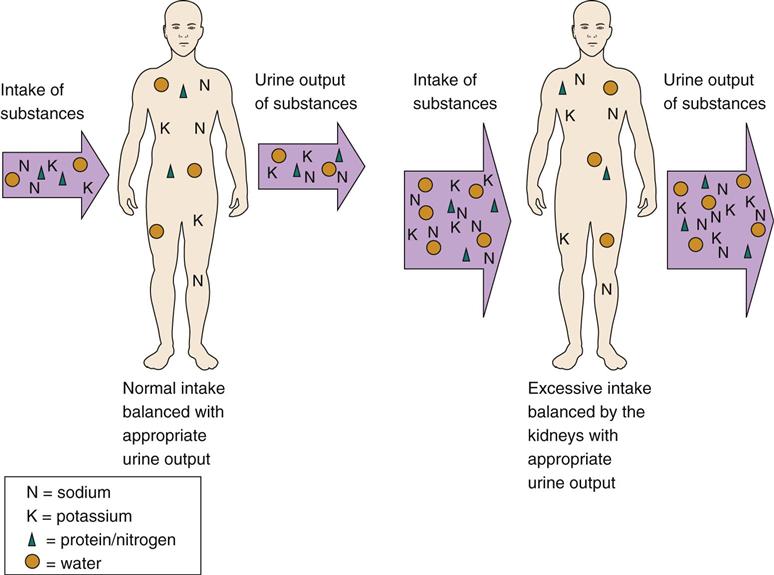Concept Overview
Urinary Elimination
The need for urinary elimination is really the need for homeostasis—the ability of the body to maintain its internal environment at a “steady state” and within very narrow ranges of normal, regardless of external changes. The body works best when blood and other extracellular fluids have a serum sodium concentration of 135 to 145 mEq/L (mmol/L) and a serum potassium level of 3.5 to 5.0 mEq/L (mmol/L). Serious health problems and death occur when these electrolytes are much higher or lower than these normal ranges. Keeping the amount of total body water, especially blood volume, within the normal range is also important to proper function and health. When blood volume is too high, hypertension develops and damages vital organs. When blood volume is too low, hypotension can be so severe that vital organs are not perfused with oxygen and become hypoxic. In addition, protein waste products containing nitrogen, such as urea, act as a poison and must be prevented from getting too high. Humans ingest many foods and liquids that contain water, electrolytes, and substances that will be converted to waste products. Without control mechanisms to balance the intake of these substances with their elimination, we would rapidly accumulate too much of everything and die.
As part of the renal/urinary system, the kidneys are responsible for maintaining this balance of what is taken into the body, what is allowed to remain in the body, and what is eliminated from the body. Although some products are eliminated in the stool, there is no discrimination or adjustment in bowel elimination. Urinary elimination, however, allows a person to eat and drink almost anything (except poisons and infectious organisms) in almost any amount without upsetting the homeostatic balance for body water, electrolytes, waste products, and blood pressure. For example, on one day a person may drink 2 L of fluids and eat food that contains 2 g of sodium and 5 g of potassium. The next day this same person may drink 3 L of fluids and eat food that contains 12 g of sodium and 10 g of potassium. Yet because the kidneys selectively adjust to change the amount of each substance that gets eliminated, the blood pressure, serum sodium, and serum potassium levels remain the same and within the normal ranges on both days. A “steady-state” or homeostatic balance of these substances is maintained because the kidneys adjust the output to match the intake (Fig. 1).

Stay updated, free articles. Join our Telegram channel

Full access? Get Clinical Tree


